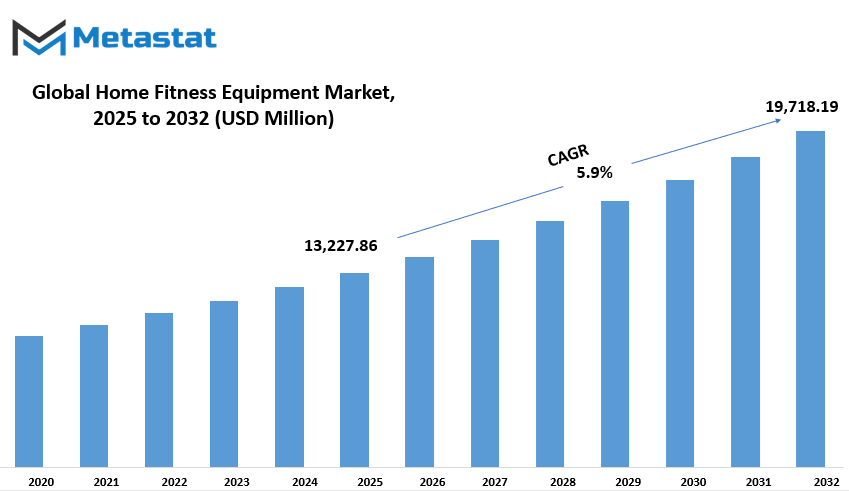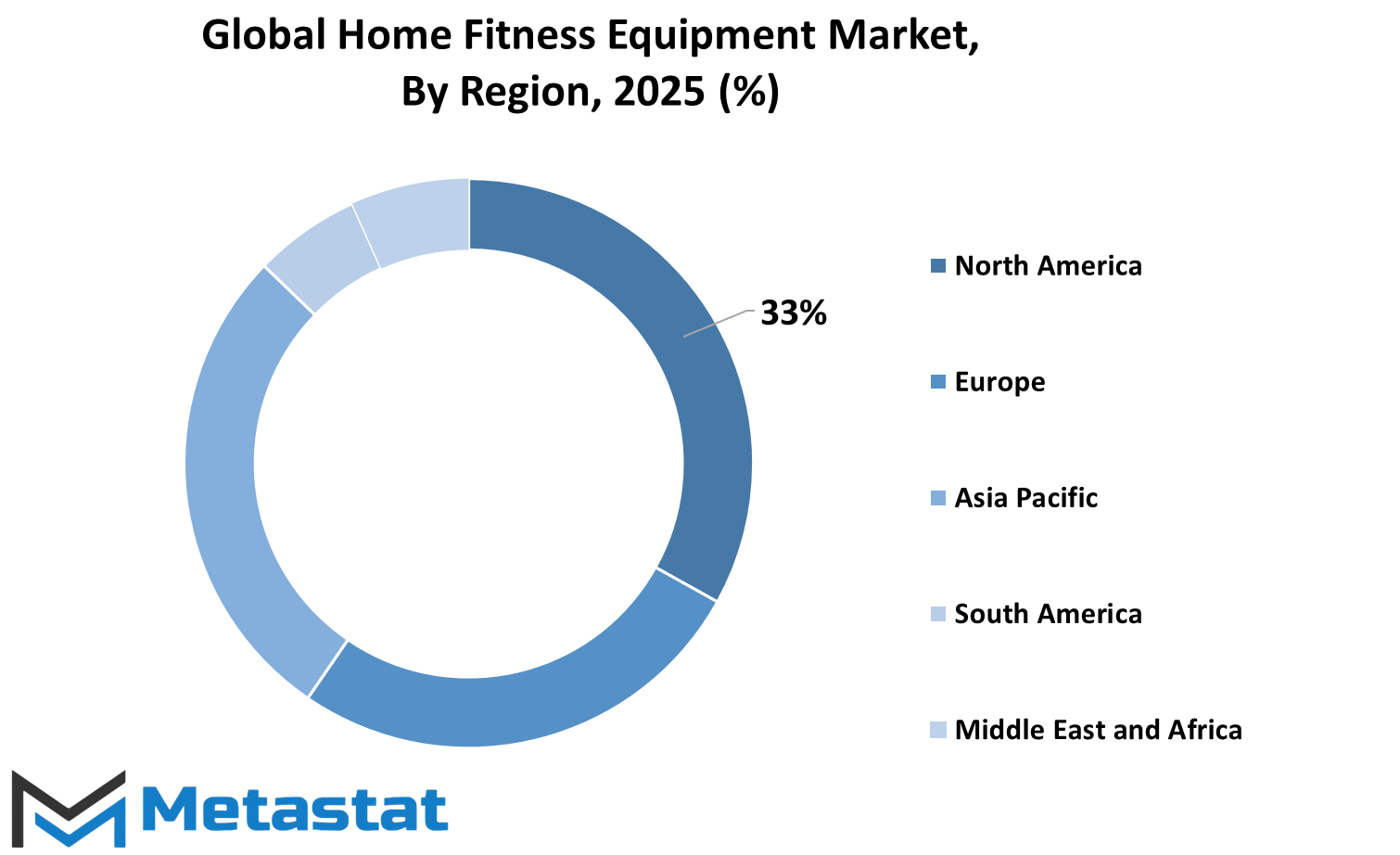MARKET OVERVIEW
In fact, the Home fitness equipment will go on playing a crucial role in defining the future of health and fitness for millions of people in years to come. As increasing numbers of people are exercising at home, this important market will be presenting new solutions which are smarter, more innovative, and focused on meeting the needs of different consumers in the near future.
The landscape will have new trends in fitness levels, preferences, and lifestyles that will see the future develop. With the growing technology integration in fitness workout solutions, the demand for connected and interactive fitness hardware is going to soar. There will be increasingly advanced attributes built in home equipment at the time when technology triggers a transformation.
These products will not be only result-oriented as they will also take care of the entire experience, including online classes for fitness, tracking, and personalized training. Consumers will be searching for a product not only offering them function but also many indirect advantages like better insights and improved connectivity. Manufacturers will thus go for presenting novel equipment able to connect with a mobile application, a virtual coach, and fitness trackers on the market.
Not only that, future development will include having fitness equipment transformed-much as all marketing spaces will be available to home fitness enthusiasts. The last piece of the traditional marketing model will then be abandoned in favor of social networking and influencer marketing as the new avenues that affect buyer behavior and shape product adoption. Such fitness lifestyles will be exercised within the online walls of several fitness brands, becoming more robust with customer reviews, virtual fitness communities, and direct-to-consumer sales. In this fashion, it would allow consumers better access to buying decisions and forge better loyalty.
The proliferation of home fitness devices in the market will open up the choice of equipment options significantly. While some of the most popular items will still include those time-tested devices such as exercise bikes and treadmills, interest in the more space-efficient, multi-functional options will continue to grow. Demand will be created for fitness equipment that folds away into easily manageable storage spaces, thus enabling training without compromising space or convenience. Demand will also rise for specialized fitness equipment for a specific goal-for instance, strength training or practicing yoga. All-in-one machines will take center stage in the market as they will highlight versatility for exercising in a wide range of exercises all in one unit.
Again, better accessibility will characterize the global market for home fitness equipment. Equipment will become fit to standard prices, and access to high-quality products will no longer be out of reach for various income levels. In fact, this will cause an opening of the market to many people who would want to buy their health and wellness investments. Perhaps with further entrenchment of the home-based fitness trend into global culture, new entrants into the marketplace will probably come forward to provide novel solutions meeting these rising consumer demands.
This is why even the Global Home Fitness Equipment market will keep bringing innovation and diversity, adapting to changes in consumer needs and the evolution of technology. In the course of time, home fitness equipment will be made even more interactive and compact, as well as cheaper because it will offer people personalized and simpler options in workouts. Such a transformation will herald a new era in fitness, one that pays attention to convenience accessibility and several functions for people of the world.
Global Home Fitness Equipment market is estimated to reach $19,718.19 Million by 2032; growing at a CAGR of 5.9% from 2025 to 2032.

GROWTH FACTORS
Many budding factors lead to the significant growth of the home fitness equipment market globally. Health awareness and fitness consciousness are primarily behind the increase in demand from consumers. Gradually, many more people understand the importance of maintaining an active healthy lifestyle. This has manifested itself in the increasing casa requirements for fitness-related equipment that can aid in meeting an individual's fitness needs at the very comfort of home.
But, all the opportunities are being sidelined by several challenges that can hinder the development of the home fitness equipment market. Some of those are heavy costs, where the initial price of buying fitness equipment is quite high. Therefore, lots of consumers avoid the bloodthirsty cost for machines, especially when they are not pretty sure about their regular usage.
The inability of limited space in urban homes is yet another. Cities are becoming more cramped and gradually makes living spaces smaller; often leaving little room for huge fitness equipment. This lack of space in homes, especially at urban sites, might cause some not to acquire large fitness machines like treadmills or elliptical machines.
Regardless of the above challenges, the future still remains bright for home fitness equipment. This is mainly because of the introduction of smart technology and interactive features in the future. Many manufacturers of fitness machines are upgrading their product lines with advanced technology like sensors, smart tracking systems, and virtual workout classes.
These are made for a better experience as they aim to make workouts more enjoyable and customized to the users. This is the growing market trend; thus, consumers are likely to acquire fitness products integrated with these technologies. This, and a few others, will be some of the driving forces in the years ahead, pushing the market growth bar higher.
The market for home fitness equipment around the world has some challenges. However, with increased health consciousness among the people, convenience, and introduction of smart technologies among the demand factors, it is expected to grow well and expand widely in the near future.
MARKET SEGMENTATION
By Type
The global market for home fitness equipment has witnessed considerable growth, where types of equipment have had their share in its overall expansion. Among the various categories of home fitness equipment, cardiovascular equipment has become an incredibly huge sector, with a valuation of $5,752.16 million. This includes machines and gadgets that primarily cause good cardio, such as treadmill, stationary bikes, and ellipticals. These gadgets have become so indispensable for some people who prefer training in the comfort of their own home. Mostly because they allow one to work on heart health and stamina and also grant all sorts of convenience and flexibility in workout scheduling.
Then, strength-training equipment also holds a kind of space in the market alongside this. The category includes dumbbells, kettlebells, weight machines, and resistance bands. Strength training is necessary to build muscle, improve bone density, and strengthen our body as a whole. With an increasing number of people who are concerned about achieving their fitness goals at home, the demand for such equipment has grown. Strength training is a balanced approach to fitness and is an integral part of any home workout.
Moreover, in addition to the major categories, these items are also seeing increased popularity. Accessories would include yoga mats, foam rollers, and balance boards, which assist users to get the best out of their fitness routines. Wearables include fitness trackers and smartwatches, which keep track of an individual's activity levels, heart rates, and health conditions in real-time. These gadgets are designed to have individuals maintain their motivation by being able to record their progress and fortifying them to pursue more new fitness challenges. As technology continues to advance, therefore, the demand for wearables and accessories is expected to grow, and will constitute an integral part of the home fitness experience.
Lastly, there is a category called 'Others,' which contains mixed equipment that does not find a direct mention under the major categories. This might involve, for instance, any outdoor fitness gear, special training machines, or unique workout contraptions. This category, although dwarfed by the other categories, still contributes toward an increased bottom-line figure within the home fitness market.
As the global home fitness equipment market keeps extending, all these subsectors would keep playing very significant roles in shaping the industry. The demand for all sorts of equipment will further increase, thus giving life to the consumers' desire for easy and convenient ways of keeping fit at home.
By Price Range
The home fitness equipment market is booming as more individuals turn to ways of getting fit and healthy at home. The types of equipment available at various price points have been another important factor contributing to this growth: from purchasing basic inexpensive pieces that are affordable for the masses to elaborate pieces that create a statement. These price ranges can be broadly classified into three categories: Budget-friendly equipment, Mid-range equipment, and Premium or high-end equipment. Each of these categories is targeted at a type of workout enthusiast.
Budget-friendly equipment is accessible to someone starting their fitness journey or someone looking for cost-effective ways to stay active. They are usually basic, easy to use, and economical. They may lack all the bells and whistles of current technology but are effective for fundamental home fitness programs. Dumbbells, resistance bands, and yoga mats are some examples of equipment in this category. While lacking the finer features of high-end products, these still afford the basic necessities for keeping fit and healthy.
The mid-range equipment creates a balance between quality and price. These products generally come with more features than budget-friendly products, such as adjustable resistance, built-in tracking, and increased durability. Mid-range fitness equipment is for individuals who want something versatile but durable without paying top dollar for it. Treadmills, stationary bikes, and adjustable dumbbells are examples of mid-range equipment. This appeals to those with some commitment to a fitness routine but who would also expect their equipment to put up with somewhat more severe workouts than those of budget brands, yet still not pay the premium price for that.
Premium/high-end fitness equipment is designed for the individual who is genuinely serious about his or her fitness goals and willing to invest in the finest products available. Products in this sector boast smart technology, personalized workout plans, and high customization. They are durable and built for use by a more advanced athlete or by someone wanting to take his or her fitness to the next level. Examples of premium equipment include high-end treadmills, ellipticals, and home gym systems. The price of fitness equipment tends to be high, but such products are performance-oriented and made to last for years.
The home fitness market is huge and thus accommodates many price brackets, enabling the consumer to choose what equipment he/she can afford and needs for fitness. Whichever side of the fitness spectrum him/her needs something-totally a newbie or an advanced athlete- an array of choices are available for taking him/her to the finish line.
By Distribution Channel
Consistent growth in the Global Home Fitness Equipment market is courtesy of a better understanding of physical health and the developing trend of exercising at home. The market is energized by many factors that include changing consumer preferences, technological enhancement, and convenience. Distribution channels are a very important aspect of this market, because they determine how these products reach the end consumers. These channels can be primarily divided into two categories: offline retail stores and online platforms.
Offline retail outlets provide a great traditional method of buying fitness equipment. Customers usually go to the physical shop to see, touch, and try out products before buying them. For many people, this has been the greatest lure in getting them into exercising; that is, being able to personally test the quality and functionality of the equipment offered.In addition to that, products are easily available as per customers' needs, because they could already take it home with them instead of waiting for the delivery to be made. Others prefer to shop in person because they can get personal guidance from sales workers who help them to get the proper equipment that suits the consumers' needs and preferences.
On the other hand, these are quickly getting adapted to online platforms, which will be further considered in comparison from the last decade and onwards. With the comforts of shopping from one's own home, finding different products easily with their prices and reviews, online shopping becomes a more favorite option for many consumers. As a cherry on the cake, it allows buyers to get access to a broader assortment of products which may impossible in their proximity stores. E-commerce has developed in such a way that customers can have fitness equipment drafter to their doorsteps along with many flexible payment options and quick shipping as well. The ease of online shopping, primarily because of product-related information and customer reviews, is driving most customers toward purchasing fitness equipment online.
This increased demand will definitely continue in the future as many people will continue seeking ways to remain fit in their homes. The trend is showing no sign of slowing down, as distribution channels continue to grow both offline and online. The consumers' demand for online shopping will mainly shape the future of this market, how brand products are marketed and how consumers purchase. Ultimately, home fitness equipment will satisfy as many consumers' needs as possible, whether in offline stores or online platforms, serving all types of enthusiasts in fitness.
|
Forecast Period |
2025-2032 |
|
Market Size in 2025 |
$13,227.86 million |
|
Market Size by 2032 |
$19,718.19 Million |
|
Growth Rate from 2024 to 2031 |
5.9% |
|
Base Year |
2024 |
|
Regions Covered |
North America, Europe, Asia-Pacific, South America, Middle East & Africa |
REGIONAL ANALYSIS
The global market of home fitness equipment is categorized into five major regions based on geography- North America, Europe, Asia-Pacific, South America, and the Middle East and Africa. In the case of North America, there are the three main contributors to the overall demand for fitness equipment in the region- the U.S., Canada, and Mexico. In Europe, countries such as the UK, Germany, France, Italy, and many others are categorized under the "Rest of Europe" category, which, together, account for the European market.
Asia-Pacific is home to a rapidly growing demand for home fitness equipment, being led by big players from India, China, Japan, South Korea, and others in the "Rest of Asia-Pacific" category. This region is characterized by a growing middle class and a budding interest in health and fitness, triggering the demand for home fitness equipment. South America may be a less-active region, but it holds Brazil, Argentina, and the "Rest of South America" browsing nations. The Middle East and Africa also show quite a good degree of interest in home fitness products. The Middle East and Africa are vast and stand divided into several parts- the countries under the GCC, Egypt, South Africa, and the rest of the Middle East and Africa.
These defined regional segments help in painting a clear picture of how the home fitness equipment market is present around the world. With different regions come different needs and demands arising from various factors including economic conditions, lifestyle, and culture. North America, for instance, has been on a steady path of growth due to a deep-rooted culture of fitness and wellness. Europe also, on account of an ever-growing awareness about health issues and an increasing number of fitness enthusiasts, remains an important market.
Very rapidly indeed, especially in the Asia-Pacific region, the home fitness equipment market is growing. The increased disposable income and shifting focus toward a healthier lifestyle resulted in a huge demand for fitness equipment. The others are gradually catching up, with the South American market more inclined toward home fitness solutions that are convenient. Though not as developed as other regions, East Africa and West Africa are gradually catching up in recognising the interest of fitness enthusiasts who desire quality home fitness equipment.
This, in a nutshell, says that the home fitness equipment worldwide is segmented regionally. The importance of each region is marked out with varying trends and drivers that shape their respective markets. As more and more people worldwide adopt fitness and wellness in their lives, further growth will likely be seen in that region with home fitness equipment.

COMPETITIVE PLAYERS
While several leading companies have transformed the direction and trends of the industry worldwide, the global home fitness equipment market has witnessed phenomenal growth in the last few years owing to factors such as health awareness, technological advancement, and changing consumer behavior towards exercising at home.
Among these other key players is Peloton Interactive, Inc., which has carved a name for itself in this fitness revolution with high-tech, interactive exercise bikes and subscription-dependent workout programs. Every house would have at least one member who knows Peloton as thousands are streaming all over the world. Nautilus, Inc., the other major key player, has made its identity apparent through its wide range of cardio and strength equipment, such as Bowflex. ICON Health & Fitness, Inc. is another well-known name in the industry that promises to provide state-of-the-art fitness machines under titles like ProForm and NordicTrack to ensure a proper workout at home.
Precor Incorporated has preferred its name when it comes banging about commercial grade gym equipment but has also marketed the home fitness line while designing its machines to focus on user comfort and performance. Technogym S.p.A., an Italian company, is profoundly well known due to its innovative designs and technology advanced machines that merge luxury with functionality. Matrix Fitness, Life Fitness, and Cybex International have been well-established in the fitness industry, providing strong products for both home and commercial markets while having a reputation for long-lasting, durable equipment.
Johnson Health Tech Co. Ltd. and Sole Fitness large scope fall among those well known for their wide spectrum of fitness equipment like treadmills, ellipticals, and exercise bikes. Most importantly, they develop and provide several such cardio machines for both casual and professionals alike. Another important muscle in the home fitness segment is TRUE Fitness Technology, Inc., the nationwide top manufacturer of premium equipment that suits users' preferences.
Other players like iFIT Health & Fitness Inc. and Stamina Products, Inc. focus well on developing products that satisfy affordability and quality. Xterra Fitness is one of the brands of Dyaco International, offering versatile cardio machines for home use and catering to different markets. Concept2 Inc. covers the world with rowing machines and fitness equipment that are built for maximum performance and precision. The market is busy with brands such as Horizon Fitness and Total Gym Fitness, LLC, Body-Solid, Inc., and Sunny Health & Fitness, which have put forth dynamic, affordable, and effective solutions toward home fitness.
These companies are revolutionizing how one perceives fitness, offering easy access to high-quality equipment to comfortably use at home. Indeed, a growing trend toward home fitness will create stiff competition among these leaders in the industry and birth better products and services in the future.
Home Fitness Equipment Market Key Segments:
By Type
- Cardiovascular Equipment
- Strength Training Equipment
- Accessories and Wearables
- Other
By Price Range
- Budget-Friendly Equipment
- Mid-Range Equipment
- Premium/High-End Equipment
By Distribution Channel
- Offline Retail Stores
- Online
Key Global Home Fitness Equipment Industry Players
- Peloton Interactive, Inc.
- Nautilus, Inc.
- ICON Health & Fitness, Inc.
- Precor Incorporated
- Technogym S.p.A.
- Matrix Fitness
- Life Fitness
- Cybex International
- NordicTrack
- Johnson Health Tech Co. Ltd.
- Sole Fitness
- TRUE Fitness Technology, Inc.
- iFIT Health & Fitness Inc
- Stamina Products, Inc.
- Xterra Fitness (Dyaco International)
WHAT REPORT PROVIDES
- Full in-depth analysis of the parent Industry
- Important changes in market and its dynamics
- Segmentation details of the market
- Former, on-going, and projected market analysis in terms of volume and value
- Assessment of niche industry developments
- Market share analysis
- Key strategies of major players
- Emerging segments and regional growth potential








 US: +1 3023308252
US: +1 3023308252






